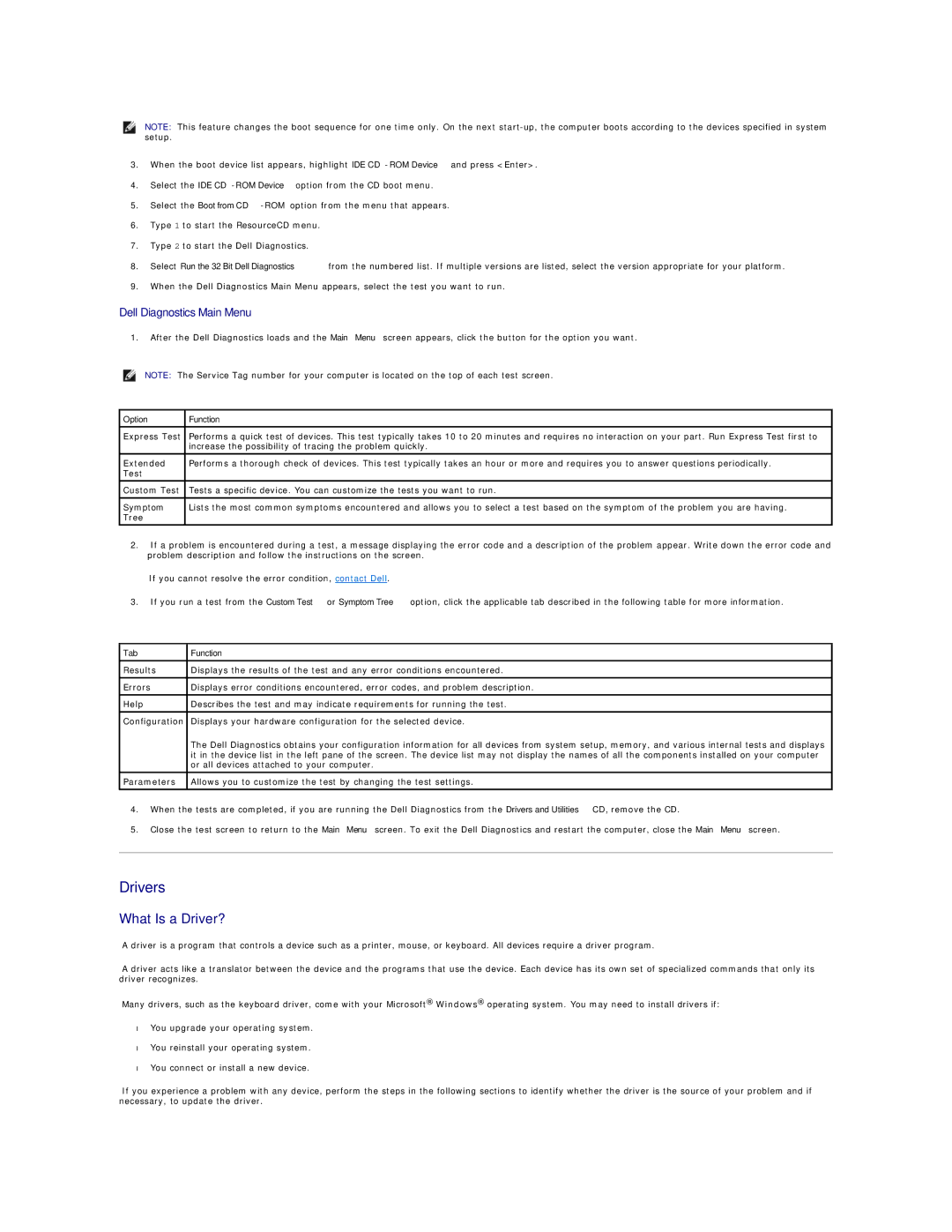
NOTE: This feature changes the boot sequence for one time only. On the next
3.When the boot device list appears, highlight IDE
4.Select the IDE
5.Select the Boot from
6.Type 1 to start the ResourceCD menu.
7.Type 2 to start the Dell Diagnostics.
8.Select Run the 32 Bit Dell Diagnostics from the numbered list. If multiple versions are listed, select the version appropriate for your platform.
9.When the Dell Diagnostics Main Menu appears, select the test you want to run.
Dell Diagnostics Main Menu
1.After the Dell Diagnostics loads and the Main Menu screen appears, click the button for the option you want.
NOTE: The Service Tag number for your computer is located on the top of each test screen.
Option | Function |
|
|
Express Test | Performs a quick test of devices. This test typically takes 10 to 20 minutes and requires no interaction on your part. Run Express Test first to |
| increase the possibility of tracing the problem quickly. |
Extended | Performs a thorough check of devices. This test typically takes an hour or more and requires you to answer questions periodically. |
Test |
|
|
|
Custom Test | Tests a specific device. You can customize the tests you want to run. |
|
|
Symptom | Lists the most common symptoms encountered and allows you to select a test based on the symptom of the problem you are having. |
Tree |
|
2.If a problem is encountered during a test, a message displaying the error code and a description of the problem appear. Write down the error code and problem description and follow the instructions on the screen.
If you cannot resolve the error condition, contact Dell.
3.If you run a test from the Custom Test or Symptom Tree option, click the applicable tab described in the following table for more information.
Tab | Function |
|
|
Results | Displays the results of the test and any error conditions encountered. |
|
|
Errors | Displays error conditions encountered, error codes, and problem description. |
|
|
Help | Describes the test and may indicate requirements for running the test. |
|
|
Configuration | Displays your hardware configuration for the selected device. |
| The Dell Diagnostics obtains your configuration information for all devices from system setup, memory, and various internal tests and displays |
| it in the device list in the left pane of the screen. The device list may not display the names of all the components installed on your computer |
| or all devices attached to your computer. |
Parameters | Allows you to customize the test by changing the test settings. |
|
|
4.When the tests are completed, if you are running the Dell Diagnostics from the Drivers and Utilities CD, remove the CD.
5.Close the test screen to return to the Main Menu screen. To exit the Dell Diagnostics and restart the computer, close the Main Menu screen.
Drivers
What Is a Driver?
A driver is a program that controls a device such as a printer, mouse, or keyboard. All devices require a driver program.
A driver acts like a translator between the device and the programs that use the device. Each device has its own set of specialized commands that only its driver recognizes.
Many drivers, such as the keyboard driver, come with your Microsoft® Windows® operating system. You may need to install drivers if:
•You upgrade your operating system.
•You reinstall your operating system.
•You connect or install a new device.
If you experience a problem with any device, perform the steps in the following sections to identify whether the driver is the source of your problem and if necessary, to update the driver.
